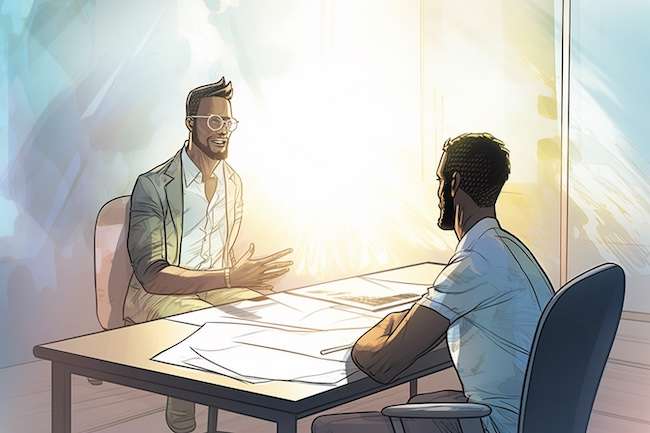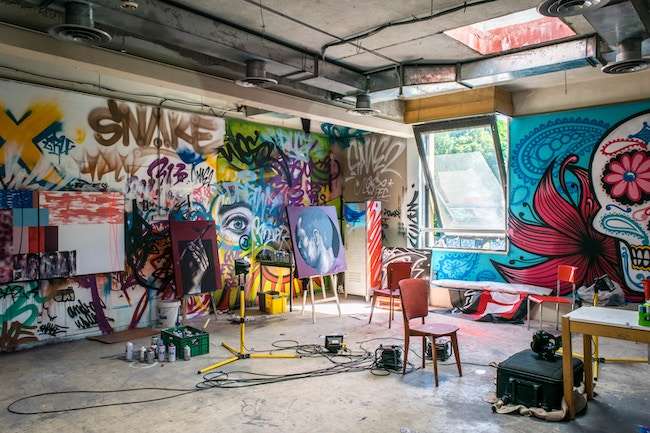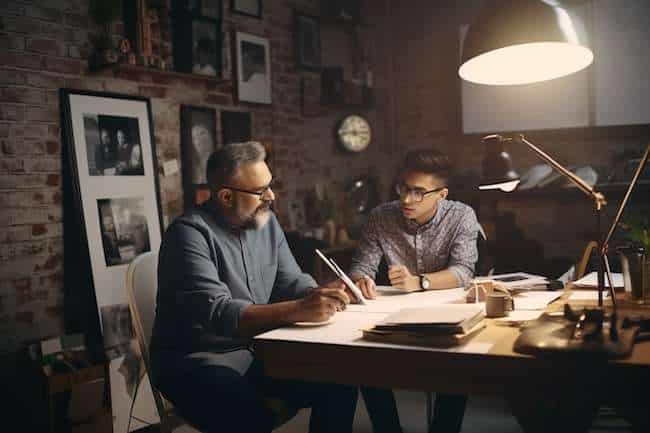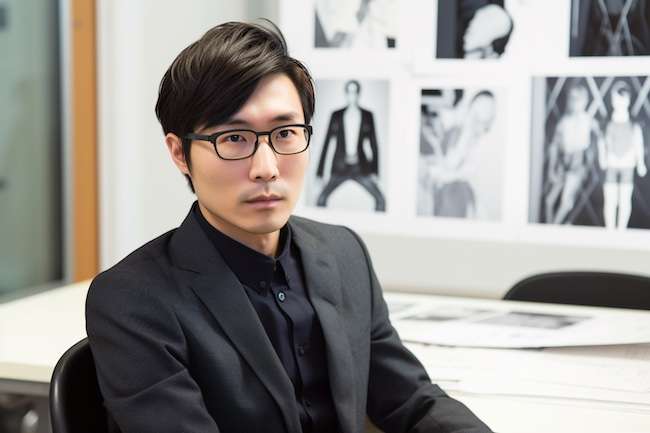(Updated) As an artist or designer trying to get that next freelance gig, art commission, gallery representation, or full-time job, you’ll face interviews with various members of the arts community. How you answer these artist interview questions can make or break the opportunity, so preparing and practicing your responses in advance is good practice.
Preparation and practice will help you feel more confident and in control, and that confidence will also come across to your interviewer, making you seem more professional and assured. Plus, preparation can also help you avoid any embarrassing mistakes that could come back to haunt you later in your career.
This comprehensive guide will dive into ten common artist interview questions you should be prepared to answer. We’ll provide detailed explanations and examples to help you understand how to respond effectively.
We suggest writing down your answers and practicing saying them aloud. You should be able to answer them without thinking about it, so you won’t ramble trying to come up with words on the spot. Remember to stay away from filler words such as “um, like, ah, well, you know.” Role-play with a friend. Videotape yourself answering these questions or any other you may have encountered in past interviews. Get feedback from others who can observe how you’re coming across. And, of course, most importantly – be yourself!
Artist Interview Questions: From the Routine to the Unexpected
1. Can you tell me about yourself?
When discussing your background, it’s essential to focus on your personal history and culture, which have shaped your artistic perspective. Highlight those aspects that make you and your work unique, with bonus points if you can tie your life experiences to your artwork. Did your upbringing prompt a specific reference point within your work? Is your work informed by certain concepts or themes from your childhood, background, socio-economic status, and where you lived or were raised? How does this impact how you see the world and create art?
You should also discuss the self-taught experiences contributing to your artistic development. Highlight any mentors who have guided you or specialized training that has impacted your artistic practice. This answer should also correspond with your artist statement that you may be used to describe yourself on websites that showcase your work. (See Crafting the Perfect Artist Statement.)
Example:
“I was born and raised in a multicultural household in a big city. The neighborhood was very diverse, and the cultural influences I experienced growing up have significantly impacted my artistic vision and the themes I explore in my work. I have always been fascinated by how images can evoke emotion and connect people across different backgrounds. I try to address issues of identity, belonging, and the blending of cultures in my work.
My mentor, Person A, was also drawn to the same themes in his work. He helped me refine my technique and creative process so I could be a better visual storyteller and encouraged me to attend workshops that allowed me to explore new mediums, styles, and techniques that I have since incorporated into my work.”
2. What does your work aim to say?
Many artists would consider this a somewhat loaded question. The mere idea of putting into words what you’re obviously communicating visually is like dancing to architecture. However, this question does have a point for the interviewer as it can help them assess how well you can articulate your artistic point of view and your intentions and goals as an artist.
Think about what drives you to create art. What themes, emotions, or concepts are you trying to convey through your work? What do you hope audiences will take away from your art?
You should discuss the elements within your artwork that help communicate your intended message. Describe your medium, color palette, subject matter, and composition. Explain how these aspects work together to form a cohesive narrative that encourages viewers to engage in a dialogue about your work.
Example:
“My work explores the relationship between humans and the natural world. I want to raise awareness about environmental issues and foster a deeper connection between people and the planet. I want my work to inspire viewers to reflect on their own impact on the environment and consider the consequences of their actions on future generations.
To get this message across, I create abstract representations of landscapes, including detailed depictions of endangered species. I incorporate natural elements such as leaves, branches, and soil into my pieces. I use a color palette that is often earthy and muted, emphasizing the organic qualities of my materials. By combining these elements, I hope to create a visual language that invites viewers to confront the beauty and fragility of our natural world and question our role within it.”

Explain how the various elements of your art or design work together to form a cohesive narrative.
3. Who are your biggest influences?
Every artist has a handful of other artists they look to for inspiration and guidance. It may be hard to hone them down to just a few but pick the artists that most influence the work you are presenting in your portfolio. Use those artists to help the interviewer connect your work to a broader context within the history of art that they are already familiar with. Then explain why you’re drawn to these influences and how they have shaped your creative process.
Provide specific examples of how these influences manifest in your artwork. Discuss the techniques, themes, or visual elements you’ve borrowed or adapted from your influences, and describe how they contribute to your unique artistic voice. Avoid using jargon or art-speak that sounds smart but provides no real insight into your work.
Example:
“I am enamored by the works of abstract expressionists like Mark Rothko and Jackson Pollock and the minimalist approach of Donald Judd and how these artists have challenged the traditional notions of art. Their bold use of color, form, and composition inspired me to push the boundaries with my own artistic style and techniques.
For example, I often use large-scale canvases and bold color palettes to evoke emotion and energy while incorporating geometric shapes and clean lines to create a dynamic tension between chaos and harmony, a theme that I have always found fascinating.”
4. How has your career developed and evolved?
Contrary to popular belief, ‘making it’ in the art world isn’t merely a game of luck. It requires a strategic and determined effort based on your vision, goals, and what success means to you. If you’re sitting down for an interview, they’ll want to know that you’ve been thinking about your career trajectory and are worthy of investment.
You should begin by reviewing your educational and professional background, including any exhibitions you’ve participated in. Have you won any awards? How did those opportunities come about? How do you get your work out into the world, and have you solidified a base of followers and contacts? Avoid giving an answer that might indicate that your success has been nothing more than happenstance rather than the result of a thoughtful approach to your career and desire to succeed.
Example:
“Over the years, I’ve been fortunate to participate in several group exhibitions and artist residencies, both locally and internationally. These experiences have provided me with valuable exposure and allowed me to connect with fellow artists and art professionals, fostering a sense of community and support. Additionally, I’ve pursued formal education in the arts, obtained a Bachelor’s degree in Fine Arts at XYZ University, and have attended various workshops to hone my skills further.
I know that relationships can be the building blocks for a successful career, so I’ve spent a lot of time networking and meeting other artists and people influential in the arts community. I regularly attend gallery openings, panel discussions, and art fairs to stay on top of the latest trends and opportunities and know which artists are hot right now.
I am also very active on social media, with over 100,000 followers on Instagram. I use Artrepeneur to sell and share my work, and I use youtube to host videos of my process to show potential buyers and collectors what goes into creating my work so they understand its value and pricing.”
5. Describe your studio or workspace.
This artist interview question is very common as it allows the interviewer to gain a deeper insight into your creative process. First, provide a general overview of your studio or workspace, describing its size, location, and any unique characteristics that make it conducive to creating.
Then delve into the specific elements of your workspace that are essential to your creative process. Discuss the tools, materials, or resources you rely on to produce your work and any organizational systems or rituals you have in place to maintain productivity and focus. By sharing these details, you will give the interviewer a glimpse into your day-to-day life as an artist and create a deeper connection with your audience.
Example:
“My studio is in a converted warehouse space, providing ample room for large-scale paintings and installations. The high ceilings and abundant natural light create an inspiring atmosphere, while the industrial surroundings contrast my work’s organic forms and textures. I’ve filled my workspace with plants and personal mementos, fostering a sense of comfort and inspiration.
Within my studio, I have designated areas for different stages of my creative process – a corner for sketching and planning, a central area for painting, and a separate space for storing materials and finished pieces. I rely on a variety of tools and materials, from traditional paintbrushes and canvases to digital tools like tablets and software. To maintain a productive workflow, I keep a detailed calendar and set goals for each project, allowing me to stay on track and measure my progress.”

Provide a general overview of your studio or workspace and how it helps you create.
6. What is your dream project?
Answering this question allows you to share your artistic aspirations and demonstrate your passion for your craft. Describe your dream project in detail, including the scope, scale, and subject matter. Explain why this project is significant and how it aligns with your artistic vision and goals.
Discuss the steps you would take to bring this dream project to fruition. Consider the resources, collaborations, or opportunities necessary to make the project a reality. By outlining a plan for achieving your dream project, you demonstrate your commitment to your artistic practice and your ambition to take your work to new heights.
Example:
“My dream project is to create a large-scale, immersive installation that explores the intersection of nature and technology. This project would create an environment where visitors can engage with various interactive elements, such as digital projections, soundscapes, and sculptural elements that each focus on a different endangered species and the impact its loss has on biodiversity and humanity. The goal is to encourage reflection on our relationship with the natural world.
To realize this ambitious project, I would need to secure funding through grants or partnerships and collaborate with other artists, designers, and technologists to develop the necessary components. I would also look for exhibition opportunities to show part of the project at art galleries and also look for grant opportunities that support experimental, immersive art experiences and may provide funding for this type of project.”
7. What’s the best piece of advice you’ve received as an artist?
The interviewer often wants to understand your openness to learning and growth better. Frame your answer to this artist interview question by recounting the advice or guidance you received, who it was from, and the situation or reason why it came about. Explain why this advice resonated with you. Discuss the ways in which you have applied this advice to your work or career.
Example:
“One of the most valuable pieces of advice I’ve received came from a mentor who encouraged me to embrace vulnerability in my work. She emphasized the importance of being open and honest in my artistic expression, as this would allow me to forge deeper connections with my audience and create truly authentic work.
So, I’ve made a conscious effort to confront my fears and insecurities, creating personal narratives about those fears and incorporating them into my artwork. It wasn’t easy to express myself in that way, but I believe it has made a positive difference that can be seen when comparing my recent work to my earlier works.”

Discuss the ways in which you have applied advice from your mentors to your work or career.
8. How do you overcome creative blocks?
Every artist will have creative blocks throughout their career. While the blocks will always clear over time, you won’t have the luxury of taking weeks to get your creative juices flowing again in many jobs or freelance gigs. How you deal with a creative block says a lot about your character and ability to navigate the challenges inherent in the creative process.
First, you should acknowledge that you have had creative blocks and let the interviewer know you have a process for dealing with them. Then you can describe your strategies to confront and move past these obstacles. You might discuss methods such as seeking inspiration from other art forms, engaging in physical activities, or experimenting with new techniques.
You should provide specific examples of times when you’ve faced a creative block and how your strategy successfully got your creative mind back on track. Phrase your approach as a teaching moment for the interviewer and other artists so that they may use this method when they find themselves in a similar position.
Example:
“Creative blocks are an inevitable part of the artistic process, and I’ve found that having a variety of strategies in place to address them is essential. When I am frustrated and feel like I have no creative ideas, I put down the brush and take a few hours off to explore other art forms, such as literature, music, or film, that may inspire me. I also find that physical activities like hiking or yoga can help clear my mind.
I often start experimenting with new techniques, styles, or materials, which will give me a fresh perspective and can kick my creativity back into gear.
When I was working on a series of paintings exploring identity and belonging themes. I couldn’t find a unique way to communicate what was in my head, and I was on a deadline to produce the work for a client that had commissioned the work.
So, I took a walk, and when I returned to the studio, I started a collage incorporating found materials I picked up on the walk. I had never done a collage before. This ended up not only helping me overcome my block pretty quickly, but I have also continued experimenting with found materials and have used them in some of my other works.”
9. How do you stay motivated and productive in your art practice?
Discussing your motivation and productivity strategies demonstrates your ability to maintain focus and drive. First, you need to figure out what motivates you. Why are you doing art in the first place? Then tie that reasoning into how you go about your work day.
Provide specific examples of routines, habits, or strategies that help you maintain motivation and productivity in your art practice. This might include setting clear goals, maintaining a consistent work schedule, or creating a supportive studio environment. By sharing these strategies, you can offer insights into your work ethic and dedication to your craft.
Example:
“I love telling stories and communicating intriguing and thought-provoking ideas, and I want to get them out into the world. Rather than writing or talking about them, I like communicating important ideas through art. Plus, I can lose the overarching narrative if I don’t get them out of my head and onto paper.
So I have developed a set of routines and habits that help me stay on track. One of these is setting clear, achievable daily goals for each project and regular checkpoints to assess progress and adjust plans as needed. I also maintain a consistent work schedule, which helps me develop a rhythm so I remain productive even when what I am trying to create isn’t working out the way I want. I also ensure that my workspace is filled with inspiring books, artwork, and materials that can help fuel my creativity and maintain my motivation.”
10. How do you balance your personal life and your art practice?
As artist interview questions go, this is one of the list’s most popular and important ones. We all have personal things that, if not checked, could overwhelm us. You may have a newborn baby or get into a new relationship and want to spend all your time with your new partner. Conversely, you may have so many projects that you neglect your family and friends.
Balancing personal life and art is a challenge many artists and designers face, mainly if you work at home or in a studio and not in an office environment. Discussing your approach to maintaining a live/work balance demonstrates your ability to manage your time effectively and prioritize your well-being.
In answering the question, explain how vital maintaining balance is for your mental health and the long-term sustainability of your career as an artist. Consider specific examples of achieving this balance in your daily life. This might include setting boundaries for work hours, dedicating specific times for self-care and relaxation, or finding ways to integrate your personal life and art practice.
Example:
“Achieving a healthy balance can be really difficult. I always want to be in the studio creating, so without a healthy balance, I don’t believe I could maintain the energy and creativity needed to produce meaningful work nor maintain the relationship I need to be happy. I would likely burn out.
So I am diligent about setting boundaries for my work hours, ensuring dedicated time for relaxation, entertainment, and spending time with friends and family. For example, I might schedule my studio time from 9 am to 3 pm and then back in from 5 pm to 7 pm, allowing me to focus on my art and be back in the house when my daughter gets home from school. Then I can spend a couple more hours working before tucking my daughter into bed and spending the evening with my wife or our friends.”
——-
Preparing answers for artist interview questions involves anticipating and practicing thoughtful responses to various topics that dive into your background, artistic practice, influences, career development, and more. By providing comprehensive and detailed answers, you demonstrate your professionalism, commitment, and self-awareness as an artist, which can leave a lasting impression on interviewers.
There is More to an Interview than Just Answering Questions

In the interview, you should dress to reflect the job.
Just remember that being able to answer these artist interview questions is only one part of the interview. Before any interview, consider these additional preparation suggestions to ensure you are well-equipped to make a strong impression:
- Research your interviewer: Familiarize yourself with the background and interests of the person or organization conducting the interview. This can help tailor your responses to their concerns and create a more engaging conversation.
- Review your portfolio: Make sure you have a thorough understanding of your own work and can confidently discuss each piece in detail, including the inspiration, process, and techniques involved.
- Develop an elevator pitch: Prepare a concise, engaging, and informative introduction to your work and yourself as an artist. This can help you start the conversation on a strong note and set the tone for the rest of the interview.
- Practice active listening: Pay close attention to the interviewer’s questions and comments during the interview. Respond thoughtfully and directly to their concerns, demonstrating your engagement and attention.
- Dress appropriately: Present yourself professionally by wearing attire that is suitable for the context of the interview, whether that’s a gallery opening, studio visit, or meeting with a potential client.
- Bring supporting materials: Bring any relevant materials, such as a physical or digital portfolio, artist statement, CV, or exhibition catalog, that can help you better illustrate your points and showcase your work.
If your interview is online, check out our article on Mastering the Remote Creative Job Interview.
Investing time and effort into preparing for your artist interview can increase your confidence, reduce anxiety, and showcase your best self as an artist. Remember that the interview is an opportunity to share your passion, dedication, and talent with others, so embrace the process and enjoy discussing your work with those genuinely interested in learning more about you and your art.
How do you handle tough questions, or what questions are missing from this list? Let us know in the comments!
